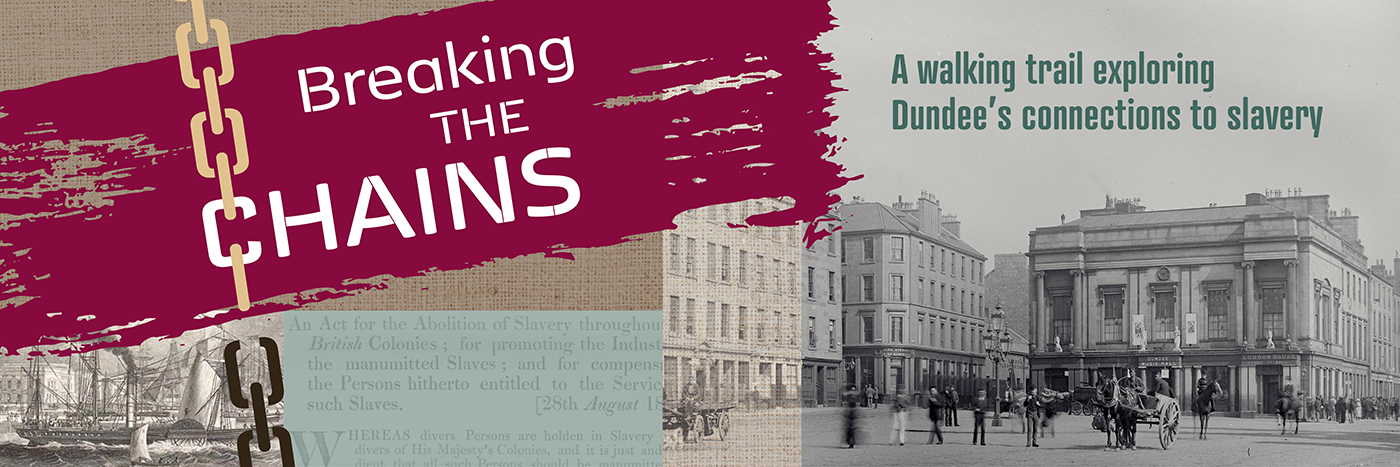Breaking The Chains
A walking trail exploring Dundee’s connections to slavery
As a major trading port, Dundee was inevitably drawn into the transatlantic slave trade. Dundee merchants and shipowners were quick to realise the profits that could be made in Africa and the Fraternity of Masters and Seamen were among those who invested in the Company of Scotland Trading to Africa and the Indies, set up in 1695 (later to become the ill-fated Darien Company).
Soon after the Act of Union in 1707, Dundee merchants were among many in Scotland petitioning Parliament to complain about a proposed monopoly by the English Royal African Company. The town’s growing linen industry gave it a valuable commodity to trade with, and Dundee linen (particularly a coarse cloth called osnaburg) was bought in huge quantities by slaveowners in the West Indies and the United States of America.
Dundee therefore had little interest in opposing the transatlantic slave trade and it was not until 1832 (a year before the trade was abolished) that the first Anti-Slavery Society was formed here. After abolition the focus shifted to the US. While Dundee merchants continued to profit by selling linen to American slaveowners, anti-slavery campaigners waged an increasingly vocal campaign in the town, and many previously enslaved people were invited to Dundee to speak about their experiences.
This city centre trail presents just some of Dundee’s many connections to 18th and 19th century slavery. It begins outside the Tower Building at the University of Dundee and ends outside The McManus: Dundee’s Art Gallery & Museum.
Please note - This trail is step-free but involves some uneven surfaces. There are also some busy roads to cross so please take care and be aware of your surroundings. Some parts of the route are not well-lit at night so we recommend undertaking this only in daylight.
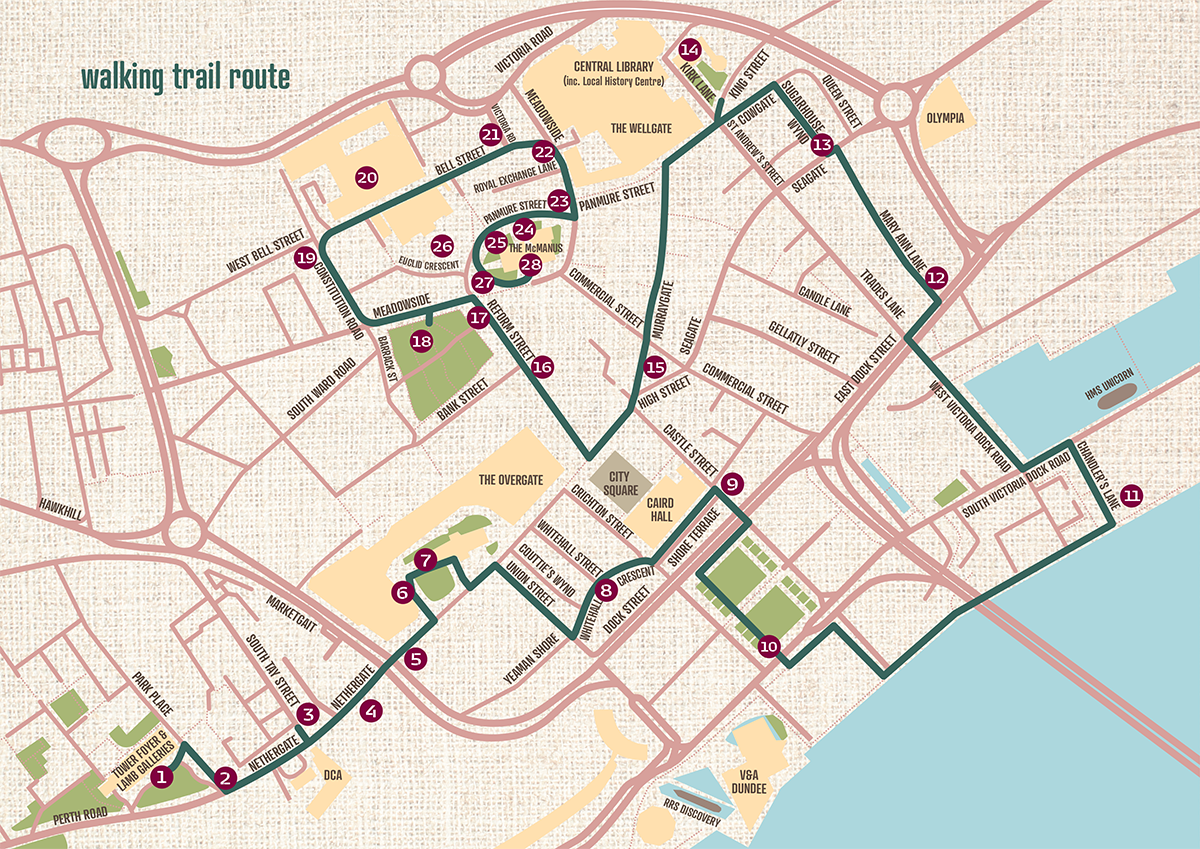
1. Tower Building, University of Dundee
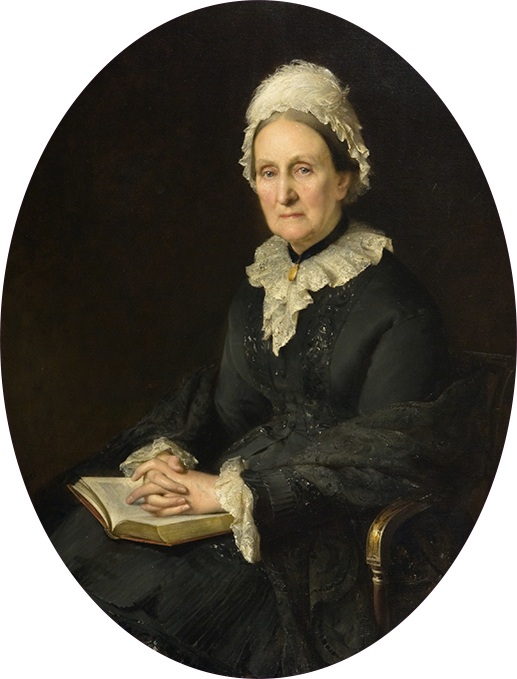
Mary Ann Baxter by Edward Hughes
(University of Dundee Museums)
The University was founded as University College, Dundee in 1881. Its principal benefactor was Mary Ann Baxter, whose wealth came from the family linen company Baxter Brothers & Co. One of their most popular products was osnaburg, a cheap and coarse linen which had long been used to clothe enslaved people in plantations in the Caribbean and the US.
2. Park Place
At 5 Park Place (now demolished) lived Rev George Lewis, minister at St David’s Free Church. In 1844 he toured the US and the following year published a detailed account of the “evil influence” of slavery. However he and his fellow Free Church ministers soon came under fire for accepting money from American slaveowners to fund their newly established churches.
3. 3 South Tay Street
This building was once home to Rev George Tod, minister at St David’s Church in the 1830s. He was President of the first Dundee Anti-Slavery Society, formed in 1832 in response to a visit to the town by Baptist missionaries, who shocked audiences with their descriptions of slavery in Jamaica.
4. 136 Nethergate
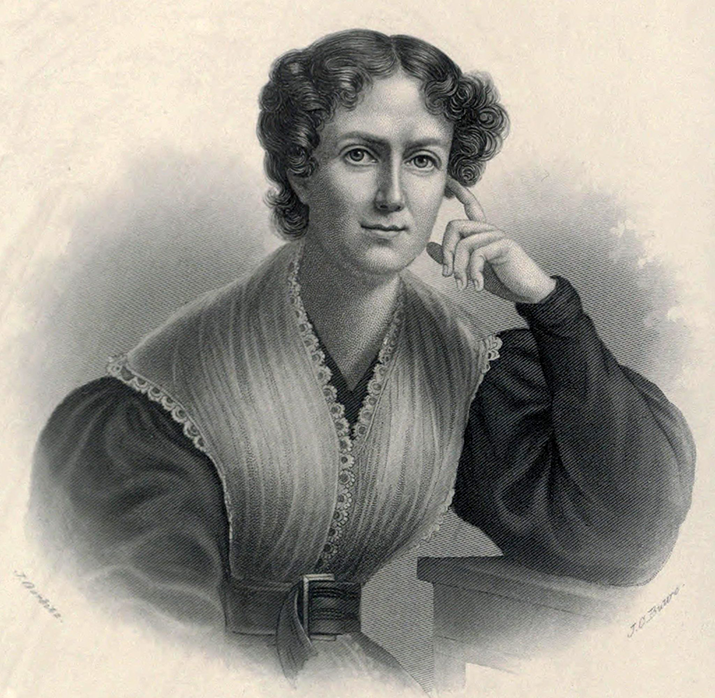
Frances Wright by Johan Gorbitz (private collection)
Two plaques on this building celebrate its significance as the birthplace of pioneering social reformer Frances Wright. In the 1820s she moved to the US where she founded the Nashoba Commune, a model farming community in Tennessee where enslaved people could work to earn money to purchase their own freedom and receive an education.
5. Meadowside St Paul’s Church
This was previously St Paul’s Free Church, where in 1858 the African American Robert M Johnson gave a talk about his experiences. Enslaved for 24 years in Kentucky, he had escaped to Canada and was at that time studying medicine in Edinburgh.
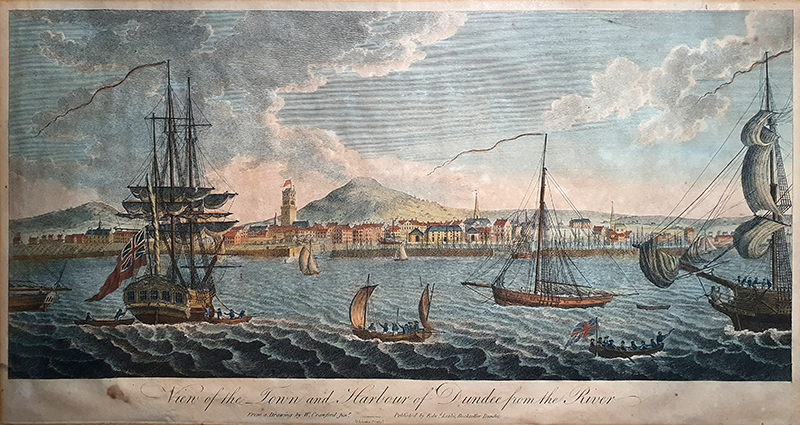
View of the Town & Harbour of Dundee from the River by William Crawford, 1793 (private collection)
6. Overgate Centre, by the Mercat Cross
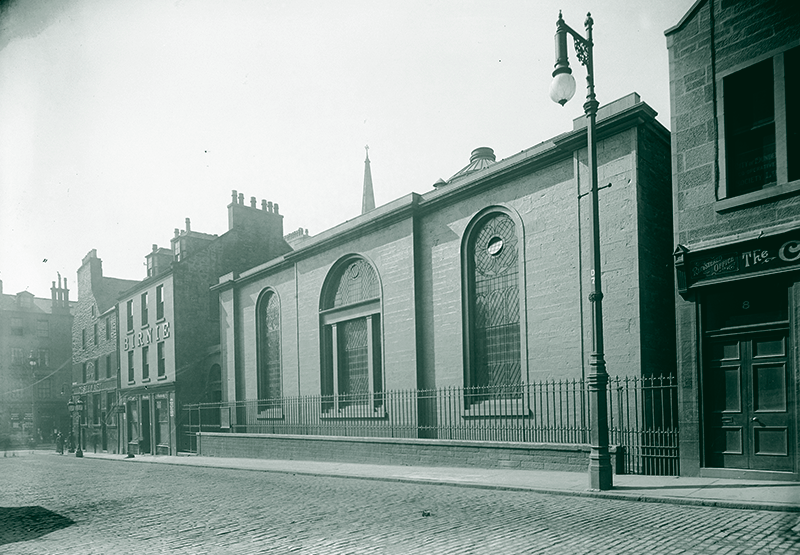
School Wynd Chapel
(Libraries, Leisure & Culture Dundee)
Near here was the site of School Wynd Chapel, run for over 40 years by Rev George Gilfillan. In the mid-19th century this was arguably Dundee’s most notable centre for anti-slavery campaigning. It hosted many talks by visitors from the US including the previously enslaved Frederick Douglass (see no 19) and Samuel Ward, and leading activist William Lloyd Garrison.
7. Steeple Church
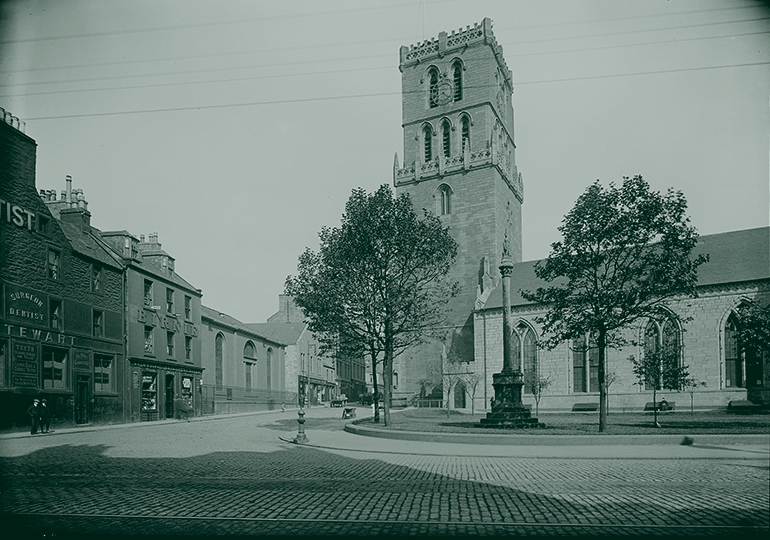
The Old Steeple
(Libraries, Leisure & Culture Dundee)
This was also an important venue for antislavery activity. Perhaps most notably, in 1853 it hosted a visit by American writer Harriet Beecher Stowe, author of Uncle Tom’s Cabin, the most popular novel of its time. The book stimulated a widespread sense of romantic pity for enslaved African Americans, though many viewed it as implying Black inferiority.
8. Gilfillan Memorial Church
Built in 1887, this building honours Rev George Gilfillan, who had died in 1878. He and his wife were Dundee’s most active campaigners against American slavery. He invited many formerly enslaved people to speak in Dundee and in 1847 he published The Debasing and Demoralising Influence of Slavery. His wife Margaret was President of the Dundee Ladies’ Anti-Slavery Association, a popular organisation in the 1850s.
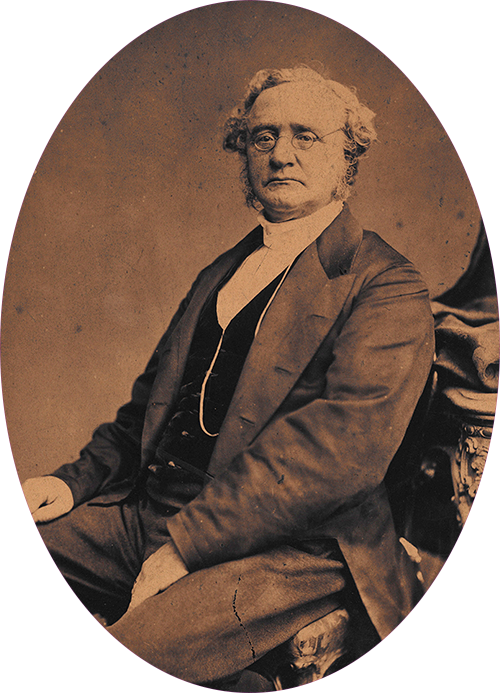
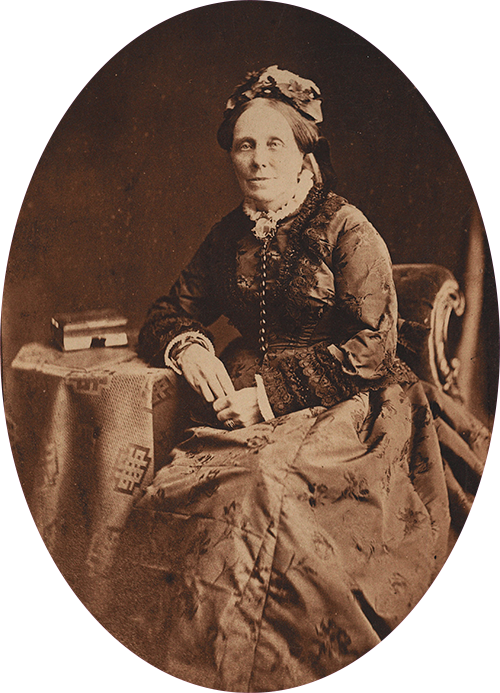
Rev George Gilfillan and Margaret Gilfillan (Dundee City Archives)
9. The Shore, 15 Shore Terrace
This building was originally the Exchange Coffee House, built in 1828-29. Located close to the docks, it featured a large chamber from which Dundee’s wealthy merchants could see the cargos they had bought and sold as they were taken on and off ships.
10. Sensory Garden, Slessor Gardens
Before the 1960s, Dock Street marked Dundee’s waterfront. The area to the east of here was the site of Earl Grey Dock, opened in 1834. It was named after Charles, 2nd Earl Grey, who was Prime Minister 1830-34. It was his government that passed the Slavery Abolition Act 1833, which made the purchase or ownership of slaves illegal within most of the British Empire.
11. Waterfront
There are no known voyages from Dundee to Africa to transport enslaved people, though records are incomplete and we know that several left from nearby Montrose. However, in 1752 a ship registered in Dundee, the Hunter, sailed from London to Sierra Leone. There it is believed to have collected 105 slaves, only 85 of whom made it to their destination in Barbados.
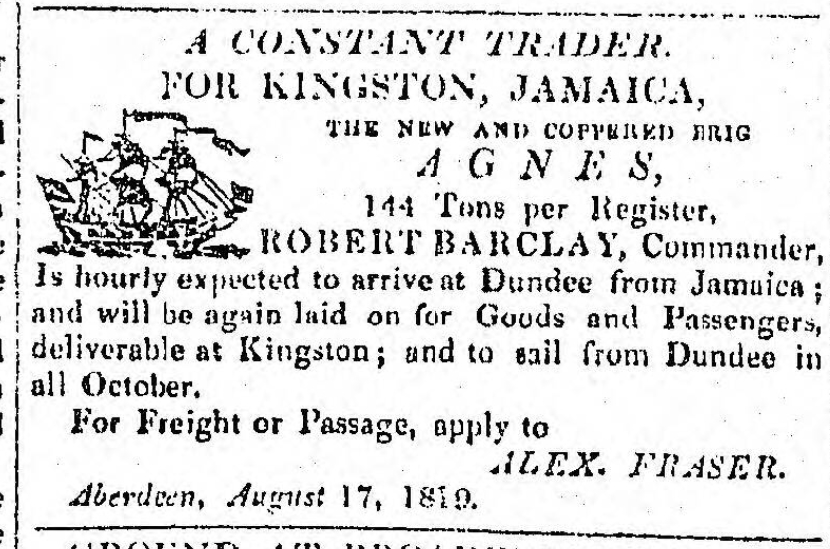
There were also many sailings between Dundee and Jamaica in the 18th and early 19th centuries, indicating direct trade in the produce of slavery. In 1797, for example, the Caledonian Mercury reported
“a brig called the Diamond… bound from Jamaica to Dundee laden with coffee, rum, and sugar.”
12. DP&L Building
The Dundee, Perth & London Shipping Company was incorporated in 1826, amalgamating two rival companies. As well as operating the busy Dundee-London route, DP&L also traded with ports on the River Clyde, using the Forth & Clyde Canal to transport sugar, molasses and rum produced using enslaved labour in Jamaica, Demerara, Trinidad, Grenada, Antigua and St Lucia.
13. Sugarhouse Wynd
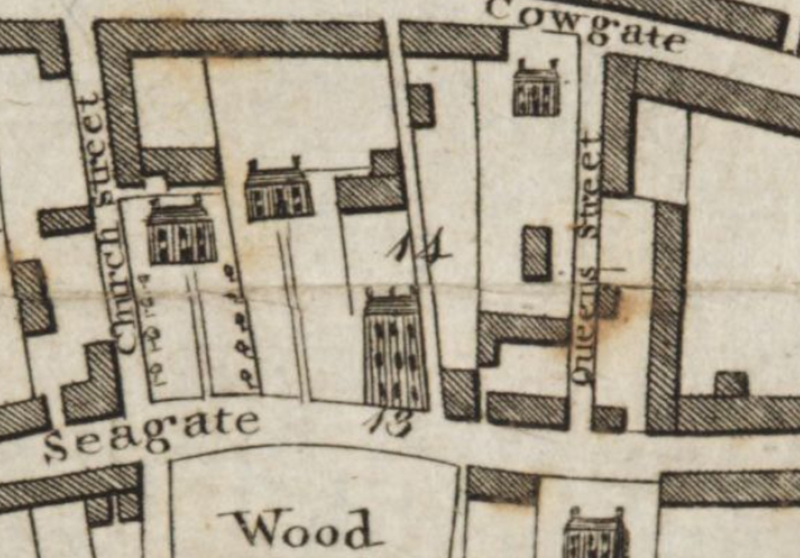
Dundee’s first sugar house was built here on the corner of Seagate and St Mary’s Wynd (now Sugarhouse Wynd) in 1767. Here raw sugar imported mostly from the West Indies was refined and packed then exported to various countries around the world. The business was never very successful and the abolition of slavery in 1833 severely reduced the supply of sugar. The building had closed by 1841.
14. St Andrew’s Church
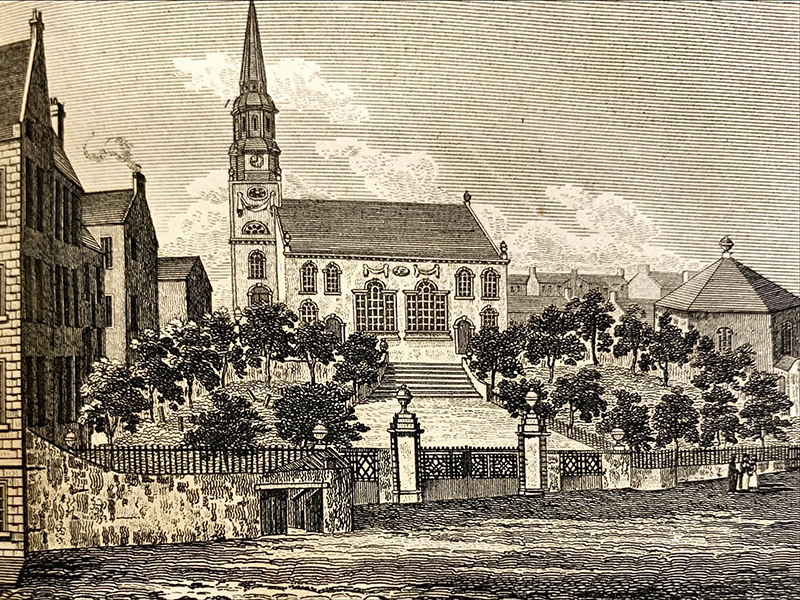
St Andrew’s Church by William Young from Dundee Delineated, 1822 (Libraries, Leisure & Culture Dundee)
St Andrew’s Church opened in 1775. Known as the Trades Kirk, its construction was funded by the Nine Incorporated Trades and Three United Trades. Many of Dundee’s wealthy merchants, who would have benefitted most from slavery, worshipped here.
15. 96 High Street (now Optical Express)
Immediately in front of this building is the site of Dundee Trades Hall, built in 1776-77 for the Nine Incorporated Trades. It was also an early meeting place for the Forfarshire Chamber of Commerce, formed in 1819 to protect the interests of local merchants. In 1823 they petitioned Parliament to object to a reduction in sugar duties, stating:
“The interests of the linen trade of this county are intimately connected with the prosperity of the West Indian Planters as your Petitioners supply Osnaburghs for the whole of their negroes’ cloathing”.
Seven years later, they refused to support the abolition of slavery, claiming it was “a moral issue” outwith their remit.
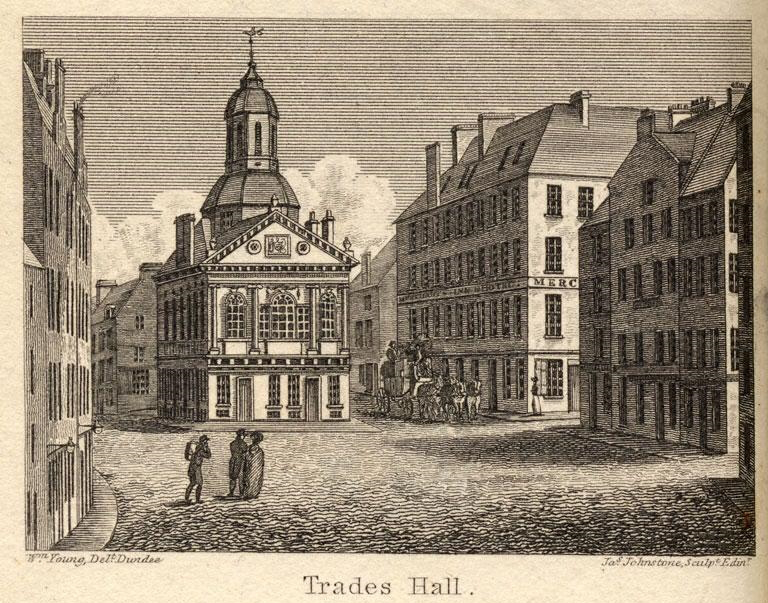
Trades Hall by William Young from Dundee Delineated, 1922 (University of Dundee Archives)
16. 41 Reform Street
16 41 Reform Street This was home to US Consul James Smith. Smith emigrated from Glasgow to America aged 17, where he became a pastor in Illinois. Abraham Lincoln was one of his congregation and when Lincoln was elected President in 1861, he appointed Smith to be US Consul in Scotland. Smith took up residence in Dundee and fulfilled this role throughout the American Civil War and after Lincoln’s assassination. Lincoln’s views on race were complex, but he is celebrated for issuing the Emancipation Proclamation in 1863 and signing the Thirteenth Amendment in 1865, leading to the abolition of slavery in the US.
17. 60-64 Reform Street
Once Lamb’s Hotel, this building was the regular meeting place of the Dundee Ladies’ Anti-Slavery Association. This was formed following a visit to School Wynd Chapel by members of the Glasgow Ladies’ Anti-Slavery Association in 1851. The Rev George Gilfillan’s wife Margaret acted as President. Their most high-profile event was a grand festival in honour of the writer Harriet Beecher Stowe (see no 7) but they also raised funds to support anti-slavery organisations in the USA and to help fugitive slaves in Canada.

18. The Howff
On entering The Howff from Meadowside look diagonally to your right to find the distinctive family tomb of the Wedderburns. On the ground before this is a horizontal stone for Sir John Wedderburn of Ballindean (1729-1803). After his father was executed for fighting on the Jacobite side at Culloden, the young Wedderburn fled Scotland and settled in Jamaica, where he was soon followed by his three brothers.
In 1752 he began purchasing land and slaves and by 1768 he had made enough money to return to Scotland and buy the Ballindean estate in Perthshire. He brought with him Joseph Knight, born in Guinea and sold into slavery in Jamaica. Knight worked for him as a servant but when he tried to leave Wedderburn he was arrested and taken to court. In a landmark ruling, the Court of Session in Edinburgh agreed that “the state of slavery is not recognised by the laws of this kingdom” and Knight was declared a free man. Wedderburn continued to invest in plantations in Jamaica, eventually owning (individually or with his brothers) four estates and nearly 1000 slaves.
19. 1A West Bell Street
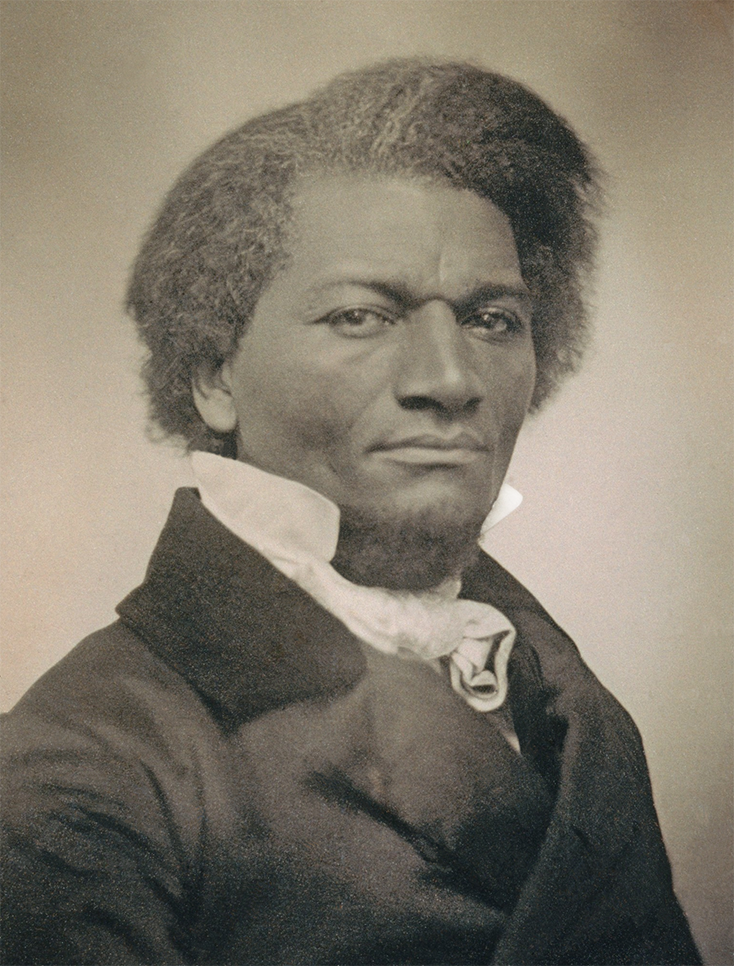
Frederick Douglass (Wikimedia Commons)
This building was formerly Bell Street UP Church. The large hall in its basement was the location in 1846 of one of the most celebrated speeches by Frederick Douglass, who had escaped slavery in the USA to become a renowned orator and social reformer. A BBC History plaque on the wall commemorates this event. The venue later hosted talks by other previously enslaved people, including William Wells Brown and Ellen and William Craft.
Frederick Douglass also spoke at several other venues in Dundee in 1846 and 1860 – the Royal Hotel (54 Nethergate), the United Secession Church in Tay Square (now site of Nethergate Medical Centre), the Relief Church in Bell Street (now Annie Lamont Building, Abertay University) and the Corn Exchange Hall (later Kinnaird Hall, now the Overgate car park on Bank Street).
20. Abertay University

This was originally founded in 1888 as Dundee Technical Institute thanks to a bequest by David Baxter. Baxter was manager of Dundee Sugar House (see no 13) before joining the family linen business in the 1830s. By that time Dundee linen was already being exported to plantations in Jamaica, Haiti, St Thomas, Cuba, Brazil and the US, all of which depended on an enslaved workforce. Baxter Brothers grew to become the world’s largest linen manufacturer, with America and the West Indies among the principal sources of its wealth. Coincidentally, the University stands on the site of an earlier mill, Chapelshade, which produced linen between 1821 and 1832.
Statue of Sir David Baxter by John Steell, Baxter Park
21. Corner of Bell Street & Victoria Road
The India Buildings were once the headquarters of the insurance company J C Smith & Co, owned by anti-slavery campaigner J C Smith. An elder of St David’s United Free Church (see no 2), he seems to have been inspired by Harriet Beecher Stowe (see no 7) to write his own anti-slavery stories for children. Isacco the African or The Slave Set Free and The Fisher Boy of the Potomac - A Story of Harper’s Ferry (both 1861) were followed by Abolition Abby - A Story of North and South (1863). Their object was “to enlist the sympathies of the young on the side of the poor American slaves.”
22. Corner of Bell Street & Meadowside
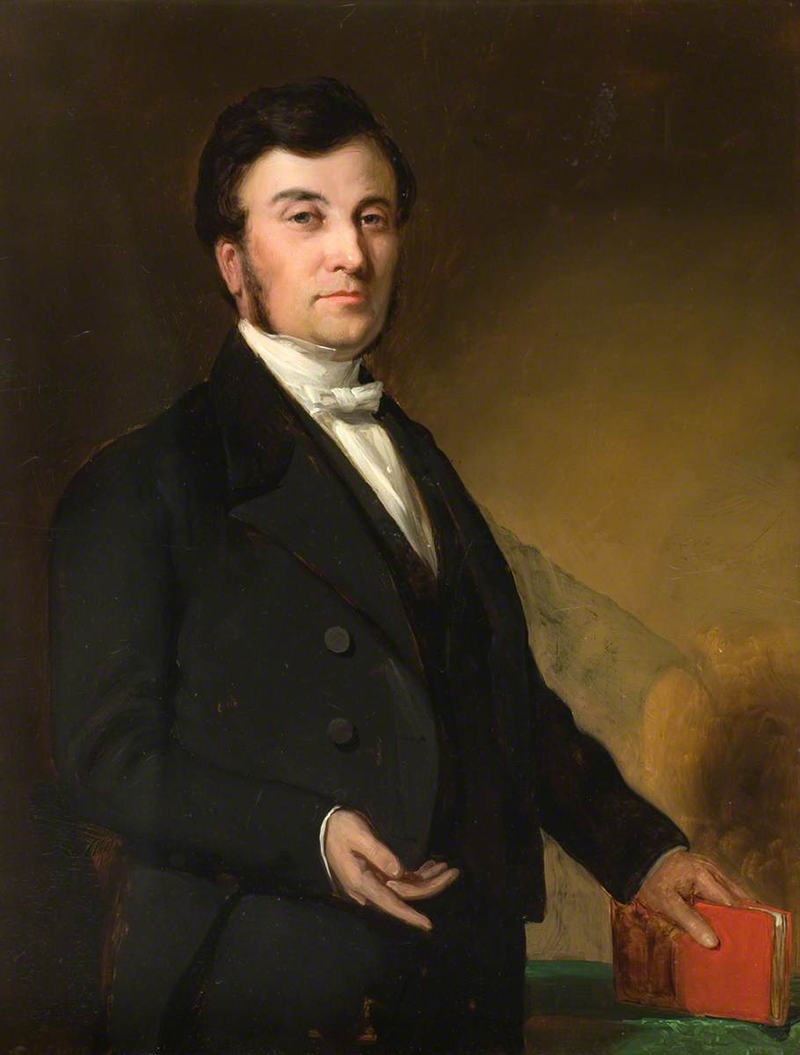
Rev William Borwick by James Edgar (Dundee Art Galleries & Museums)
On the south corner was the site of St Andrew’s Free Church, where Rev James Ewing was minister. Ewing also hosted anti-slavery meetings in the 1850s and 60s, including one in honour of the American abolitionist George B Cheever. Nearby on the opposite side was once 89 Bell Street, home of Rev William Borwick and his wife. Borwick was minister of the Bell Street UP Church (see no 19) while Mrs Borwick served as treasurer of the Dundee Ladies’ Anti-Slavery Association and was also involved in its Glasgow counterpart.
23. Chamber Building (now Chamber East)
Opened in 1856, this building was originally the Royal Exchange and became home to Dundee Chamber of Commerce, who had previously met in smaller premises at the Baltic Coffee House (on the site of the Panmure Street entrance to the Wellgate Centre). The American Civil War saw a huge demand for tents, sacks and other jute products, resulting in high profits for Dundee textile industries. In May 1863, the Chairman of the Chamber of Commerce remarked that Dundee
“would be well satisfied to have a perpetual lease of the present state of things.”
24. Statue of Queen Victoria
The British Royal Family profited from and protected the trade in enslaved people until the 19th century. Labour from enslaved Africans was key to the expansion of the British Empire. Victoria took the throne soon after the trade in enslaved people had been outlawed in most of the British Empire and was actively involved in Britain’s relationship with Africa during this transitional time. She became godmother to Aina or Ina, a Yoruba girl from Oke-Odan in present-day Nigeria. Aina was enslaved as a child and presented to British Captain Frederick Forbes. He renamed her Sarah Forbes Bonetta and introduced her to Victoria, who took a personal interest in her upbringing and education.
The British monarchy has yet to acknowledge publicly its historic role in the slave trade.
25. Statue of George Kinloch
Celebrated as Dundee’s first radical MP and a champion of political reform, Kinloch inherited a plantation in Jamaica from his father, who died in 1775 shortly after his son was born. It was managed by Sir John Wedderburn (see no 18) until George came of age and assumed ownership in 1795. It is unclear whether Kinloch ever visited the plantation but he benefitted from its income for nine years, before selling it (and around 189 people enslaved on it) in 1804 to a cousin of Wedderburn. However, when campaigning for Parliament in 1831 Kinloch publicly stated:
“I am an enemy to slavery in all its forms - to negro slavery in particular”.
26. High School of Dundee
In 1789, James Webster bequeathed the residue of his estate (some £7000) for the benefit of education in Dundee. Much of his wealth came from the income of an estate in Jamaica. The money was used to provide 71 bursaries, 21 of which went to boys attending what is now the High School.
27. Statue of Robert Burns
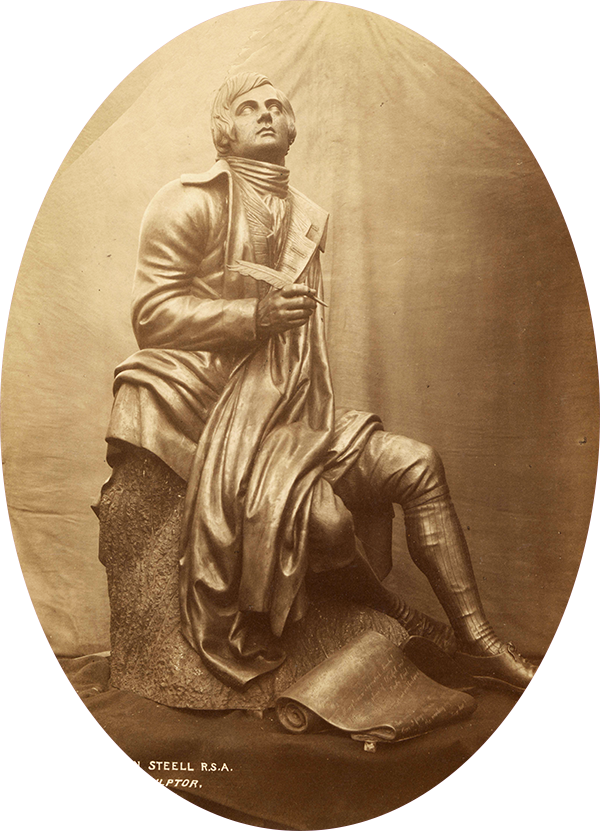
Statue of Robert Burns by John Steell (Libraries, Leisure & Culture Dundee)
While celebrated for his poem The Slave’s Lament (1792), it is often forgotten that six years earlier, Burns had intended to emigrate to Jamaica to work as a bookkeeper on a sugar plantation worked by slave labour. Three times he booked his passage on ships bound for Jamaica but each time he changed his mind, finally choosing to remain in Scotland and pursue a literary career.
28. The McManus: Dundee’s Art Gallery & Museum
The McManus was originally built as the Albert Institute in memory of the late Prince Albert. Albert was President of the Society for the Extinction of the Slave Trade and for the Civilization of Africa, which was founded after slavery had been outlawed in the British Empire. As its name suggests, however, the Society still favoured British and European involvement in, and profit from, African people and land.
The Albert Institute was funded by donations from a variety of benefactors. These included David Baxter (see nos 1 and 20) and George Armitstead, a ship owner who imported guano processed by enforced labour in Peru. Donors also included Dundonians involved in the anti-slavery movement, including Rev George Gilfillan and Rev James Ewing.
The building’s architect, Sir George Gilbert Scott, was the son of Euphemia Lynch, whose family owned an estate in Antigua. Gilbert Scott’s father made an unsuccessful claim for monetary compensation after the abolition of slavery on behalf of his wife’s aunt.
Dundee street names with connections to slavery
The trail above focuses on the city centre but there are many places elsewhere in Dundee with links to the slave trade, including streets named after slave owners or their families. The map below reveals some of these wider connections. Click on the markers to find out more.

Created by Leisure and Culture Dundee and University of Dundee Museums in association with Woven Together: Dundee’s Multicultural History Project.
Text by Erin Farley and Matthew Jarron. Map design by Dolina Mechan


